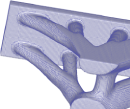Active Research
Polygonal Finite Elements: Application to Structural Topology Optimization
In topology optimization, the parameterization of design is commonly carried out on uniform grids consisting of Lagrangian-type finite elements (e.g., linear quads). These formulations, however, suffer from numerical anomalies such as checkerboard patterns and one-node connections. Moreover, the constrained geometry of these discretizations can cause bias in the orientation of members, leading to mesh-dependent sub-optimal designs. We examine the use of Voronoi diagrams to construct unstructured polygonal meshes with high degree of geometric isotropy. Due to the superior accuracy of polygonal finite elements, the resulting scheme is free of aforementioned instabilities.

Design domain for MBB beam problem (left) and the corresponding Michell solution from Rozvany, 2009 (right)

Solution based on a uniform Q8 mesh (left) and based on an unstructured Voronoi mesh (right)
Related Publications
C. Talischi, G.H. Paulino, and C. Le. "Honeycomb Wachspress Finite Elements for Structural Topology Optimization"Structural and Multidisciplinary Optimization. Vol. 37, pp. 569-583, 2009.
C. Talischi, G. H. Paulino, A. Pereira, and I. F. M. Menezes. “Polygonal finite elements for topology optimization: A unifying paradigm.” International Journal for Numerical Methods in Engineering. Vol 82, No. 6, pp. 671-698, 2010.
C. Talischi, G.H. Paulino, and C. Le. "Honeycomb Wachspress Finite Elements for Structural Topology Optimization"Structural and Multidisciplinary Optimization. Vol. 37, pp. 569-583, 2009.
C. Talischi, G. H. Paulino, A. Pereira, and I. F. M. Menezes. “Polygonal finite elements for topology optimization: A unifying paradigm.” International Journal for Numerical Methods in Engineering. Vol 82, No. 6, pp. 671-698, 2010.
Reliability Based Design and Topology Optimization
Deterministic design optimization is performed in a manner which does not take into account the uncertainties such as loads, material properties. Therefore, the resultant optimal design may have unquantified risk of violating the given constraints. Accurate and efficient reliability-based design and topology optimization (RBDO/RBTO) are used in conjunction with multiresolution topology optimization. An enhanced single-loop method is employed, which eliminates the iterations that evaluate reliability constraints in RBDO/RBTO. The matrix‐based system reliability (MSR) method enables us to compute the system failure probability and its parameter sensitivities efficiently and accurately through convenient matrix calculations. The proposed framework is uniformly applicable to general systems including series, parallel, cut set and link set system events. The results based on deterministic, component and system RBDO/RBTO approaches are confirmed by Monte Carlo simulations.
Related Publications
T. H. Nguyen, J. Song, and G.H. Paulino. "Single-loop system reliability-based design optimization using matrix-based system reliability method: theory and applications." ASME Journal of Mechanical Design. Vol 132, pp. 011005-1-11, 2010.
T. H. Nguyen, J. Song, and G.H. Paulino. "Single-loop system reliability-based design optimization using matrix-based system reliability method: theory and applications." ASME Journal of Mechanical Design. Vol 132, pp. 011005-1-11, 2010.

Result obtained using deterministic topology optimization

Result obtained using reliability based topology optimization (RBTO)
Topology Optimization Applied to Design of High-Rise Buildings
Manufacturing constraints in topology optimization have relevant applications in the mechanical and aerospace engineering industries. Further development of this field is needed to transition the technology toward practical civil engineering applications. Within this scope, we explore features of manufacturing constraints, especially pattern repetition, in the context of high-rise building design. Successful development of such ideas will lead to practical engineering solutions, especially during the conceptual phase of the building design process.
Figure illustrates pattern gradation for the conceptual design of a diagrid structure. A continuous topology optimization formulation with compliance as the objective function and constraints on the pattern geometry is utilized. From left to right: SOM's Lotte Tower, finite element mesh, and optimized design with pattern gradation constraints.
Figure illustrates pattern gradation for the conceptual design of a diagrid structure. A continuous topology optimization formulation with compliance as the objective function and constraints on the pattern geometry is utilized. From left to right: SOM's Lotte Tower, finite element mesh, and optimized design with pattern gradation constraints.
Related Publications
L.L . Stromberg, A. Beghini, W. F. Baker, and G. H. Paulino. "Application of layout and topology optimization using pattern gradation for the conceptual design of buildings." Structural and Multidisciplinary Optimization. Vol 43, No. 2, pp. 165-180, 2011.
L.L . Stromberg, A. Beghini, W. F. Baker, and G. H. Paulino. "Topology Optimization for Braced Frames: Combining Continuum and Discrete Elements." Engineering Structures. Vol 37. pp. 106-124, 2012.
L.L . Stromberg, A. Beghini, W. F. Baker, and G. H. Paulino. "Application of layout and topology optimization using pattern gradation for the conceptual design of buildings." Structural and Multidisciplinary Optimization. Vol 43, No. 2, pp. 165-180, 2011.
L.L . Stromberg, A. Beghini, W. F. Baker, and G. H. Paulino. "Topology Optimization for Braced Frames: Combining Continuum and Discrete Elements." Engineering Structures. Vol 37. pp. 106-124, 2012.
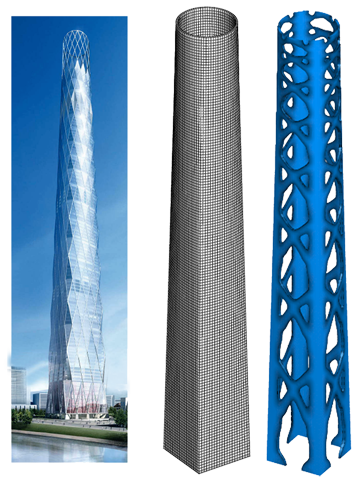
Multiresolution Topology Optimization (MTOP)
A multiresolution topology optimization (MTOP) scheme is proposed to obtain high resolution designs with relatively low computational cost. Three distinct discretization levels are employed for the topology optimization procedure: the displacement mesh (or finite element mesh) to perform the analysis, the design variable mesh to perform the optimization, and the density mesh (or density element mesh) to represent material distribution and compute the stiffness matrices. A coarser discretization is employed for finite elements and finer discretization for both density elements and design variables. A projection scheme is employed to compute the element densities from design variables and control the length scale of the material density. Various two- and three-dimensional numerical examples demonstrate that the resolution of the design can be significantly improved without refining the finite element mesh.
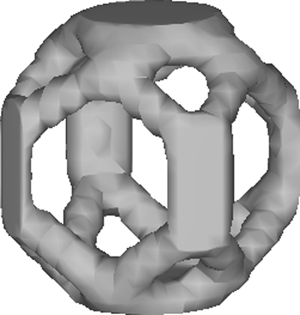
Result obtained using element based-approach
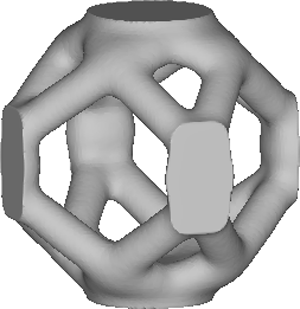
Result obtained using MTOP approach
Related Publications
T.H. Nguyen, G.H. Paulino, J. Song, and C.H. Le. "A computational paradigm for multiresolution topology optimization (MTOP)." Structural and Multidisciplinary Optimization. Vol 41, No. 4, pp. 525-539, 2010.
T.H. Nguyen, G.H. Paulino, J. Song, and C.H. Le. "A computational paradigm for multiresolution topology optimization (MTOP)." Structural and Multidisciplinary Optimization. Vol 41, No. 4, pp. 525-539, 2010.
Implicit Function Methods for Topology Optimization
In the recent years, new topology optimization formulations based on level set or implicit function description of the unknown domain have gained significant popularity. These methods are fundamentally different from the traditional density methods in that the evolution of the design from its initial shape to the final optimal configuration is guided by the motion of its boundary (see example in the figure). Both level set and phase field methods, which represent the main two classes of these formulations, do allow for certain topological changes such as merging and coalescence of holes, although in some cases, creation of holes may not be possible. One main advantage of such methods is the unambiguous definition of the design shape throughout the course of optimization, which in turn eliminates the need for devising interpolation models to describe the physics in intermediate phases. This is especially important in dynamic problems and those that involve radiations at the boundary.
The figure below illustrates the results obtained from our implementation of the phase field method (Takezawa et al., JCP (2010)) on a cantilever beam with a point load applied in the middle on the right hand side.
The figure below illustrates the results obtained from our implementation of the phase field method (Takezawa et al., JCP (2010)) on a cantilever beam with a point load applied in the middle on the right hand side.

Initial guess (left) and intermediate result after 10 iterations (right)

Intermediate result after 20 iterations (left) and converged configuration after 50 iterations (right)
GPU Accelerated Topology Optimization on Unstructured Meshes
A new generation of graphic processors is emerging, giving us the ability to solve large problems in a reasonable time. Topology optimization, being a computationally intensive algorithm, can benefit from these new processors, called GPUs. A GPU is a massively parallel architecture that requires specially crafted code to run efficiently. Early results have shown that substantial speedup can be achieved using this technology. Our ultimate goal is to build a fully automatic massively parallel topology optimization computation code that can be transparently used by other user defined codes.
GPU topology optimization was performed on a bike frame problem with realistic loads and spatial constraints applied. The resulting topology of the frame is shown to the left with the remaining components traced in red. An unstructured mesh of 20378 elements was used on the frame.
GPU topology optimization was performed on a bike frame problem with realistic loads and spatial constraints applied. The resulting topology of the frame is shown to the left with the remaining components traced in red. An unstructured mesh of 20378 elements was used on the frame.
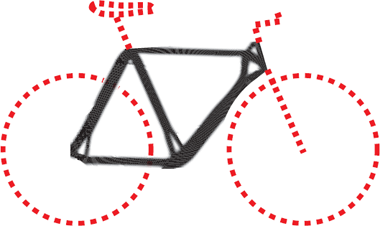
PPR: Potential-Based Cohesive Model
In the cohesive zone model, the fundamental issue for simulation of failure mechanisms is the characterization of cohesive interactions along the fracture surface. A generalized potential-based constitutive model (PPR: Park-Paulino-Roesler) for mixed-mode cohesive fracture is developed in conjunction with physical parameters such as fracture energy, cohesive strength and shape of cohesive interactions. It characterizes different fracture energies in each fracture mode, and can be applied to various material failure behavior (e.g. quasi-brittle). The unified potential leads to both intrinsic (with initial slope indicators to control elastic behavior) and extrinsic cohesive zone models.

PPR and its gradients for the intrinsic cohesive zone model
Related Publications
K. Park, G.H. Paulino, and J.R. Roesler. "A unified potential-based cohesive model for mixed-mode fracture." Journal of the Mechanics and Physics of Solids. Vol. 57, No. 6, pp. 891-908, 2009.
K. Park, G.H. Paulino, and J.R. Roesler. "A unified potential-based cohesive model for mixed-mode fracture." Journal of the Mechanics and Physics of Solids. Vol. 57, No. 6, pp. 891-908, 2009.
Adaptive Mesh Refinement and Coarsening for Dynamic Cohesive Fracture
In order to reduce computational cost in solving dynamic cohesive fracture problems, adaptive mesh refinement and coarsening (AMR&C) schemes are systematically developed. A fine mesh is utilized to capture micro-cracks and nonlinear crack tip behavior, and a coarse mesh is employed in a far field from a crack tip region in conjunction with edge-split and vertex-removal operators. The computational results of the AMR&C are consistent with the results of the uniform mesh refinement regarding crack velocity and crack patterns. The AMR&C significantly reduces computational cost while capturing both global macro-crack and local micro-cracks.
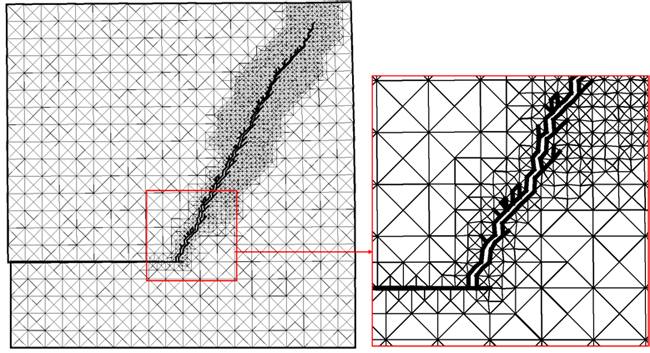
Computational result with adaptive mesh refinement and coarsening, capturing both the global macro-crack and local micro-cracks
Extraction of Cohesive Fracture Parameters using Digital Image Correlation Techniques and Inverse Analysis
Cohesive Zone Modeling (CZM) of nonlinear fracture often assumes cohesive fracture relations a-priory. In our current research, rather than making a-priori assumptions, the CZM associated with material fracture is obtained using an inverse procedure. A hybrid technique (Computational + Experimental) to extract cohesive fracture properties of elasto-plastic material using inverse analysis and digital image correlation (DIC) is under development. Inverse analysis constitutes the computational aspect and DIC constitutes the experimental aspect. As a proof of concept the technique was successfully applied to PMMA.
Below is a schematic of the hybrid technique to extract cohesive fracture properties. Also shown is a plot of the extracted traction versus separation curve obtained from inverse analysis using PPR cohesive zone model. Synthetic displacement field data with added noise is used as input for the inverse analysis scheme.
Below is a schematic of the hybrid technique to extract cohesive fracture properties. Also shown is a plot of the extracted traction versus separation curve obtained from inverse analysis using PPR cohesive zone model. Synthetic displacement field data with added noise is used as input for the inverse analysis scheme.
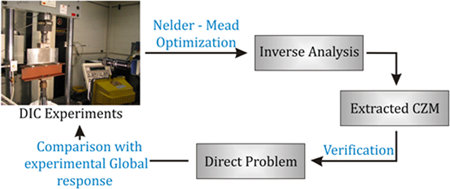
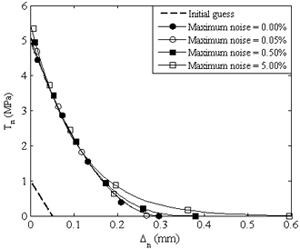
Related Publications
Shen, B., 2009. Functionally graded fiber-reinforced cementitious composites – Manufacturing and extraction of cohesive fracture properties using finite elements and digital image correlation. Ph.D. thesis, University of Illinois at Urbana-Champaign.
Shen, B., 2009. Functionally graded fiber-reinforced cementitious composites – Manufacturing and extraction of cohesive fracture properties using finite elements and digital image correlation. Ph.D. thesis, University of Illinois at Urbana-Champaign.
Unified Library of Nonlinear Solution Schemes
Many solution schemes attempt to capture the behavior of complex, nonlinear computational mechanics problems. For example, the Newton-Raphson method is suitable for some simpler problems whereas arc-length method has potential to capture highly nonlinear behavior. A unified library of nonlinear solvers makes several solution schemes easily accessible. The library includes Newton Raphson Method, Displacement Control Method, Work Control Method, Arc Length Method, Generalized Displacement Control Method, and Orthogonal Residual Procedure. The six solution schemes are unified in an N+1 dimensional space, to account for the problem size, N, and a load factor.
The figure to the right shows the highly nonlinear behavior captured with Generalized Displacement Control Method on a Lee Frame in N+1 dimensional space.
The figure to the right shows the highly nonlinear behavior captured with Generalized Displacement Control Method on a Lee Frame in N+1 dimensional space.
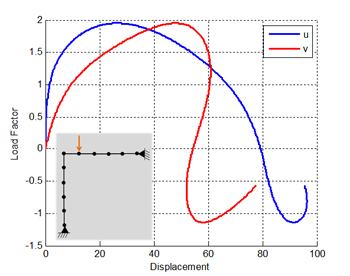
Functionally graded concrete for the civil infrastructure - A multifunctional material system approach
Functionally Graded Materials are a hybrid material approach to increasing the sustainability of future infrastructure projects. There are three different types of concrete being reviewed: virgin limestone aggregate (LCA) concrete; recycled concrete aggregate (RCA) concrete, and fiber reinforced RCA concrete. An integrated, feed-back loop between experiments and simulations is being conducted to enable the accurate modeling of functionally graded concrete slabs. The use of both tri-linear and potential based, functionally graded cohesive elements allows constant calibration between observed and computed results.
The figures to the right show the geometry and loading of the notched slab, which contains a functionally graded layer that serves as the transition zone beetween the top and bottom layers (top) and finite element mesh (bottom).
The figures to the right show the geometry and loading of the notched slab, which contains a functionally graded layer that serves as the transition zone beetween the top and bottom layers (top) and finite element mesh (bottom).
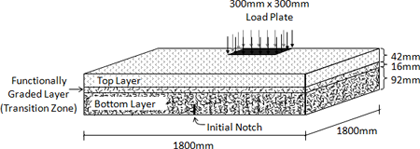

Topological Data Structure (TopS) for Finite Element Mesh Representation
Adaptive finite element analysis in which mesh geometry or topology changes during the simulation cannot be performed efficiently with the classical mesh representation (table of nodes and element incidence). For example, in dynamic fragmentation simulation based on the extrinsic cohesive element model, fractured facets must be identified and cohesive elements inserted along them. This requires fast access to those entities and efficient mesh modification operators. The TopS data structure provides compact and efficient topological support for dynamic finite element mesh representation and modification.
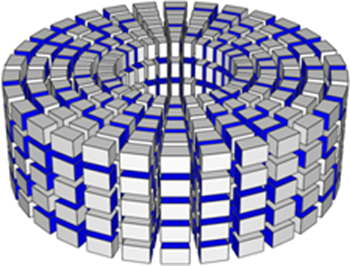
Cohesive elements inserted randomly at 20% of the facets.
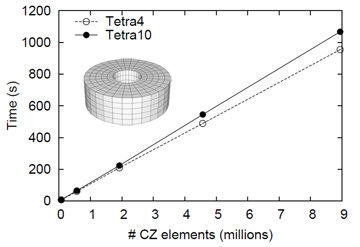
Time to insert cohesive elements scales linearly with mesh size
Related Publications
W. Celes, G.H. Paulino and R. Espinha. "A compact adjacency-based topological data structure for finite element mesh representation" International Journal for Numerical Methods in Engineering, Vol. 64, No. 11, pp. 1529-1556, 2005.
W. Celes, G.H. Paulino and R. Espinha. "Efficient handling of implicit entities in reduced mesh representations"Journal of Computing and Information Science in Engineering, special issue on "Mesh-Based Geometric Data Processing", Vol. 5, No. 4, pp. 348-359, 2005.
G.H. Paulino, W. Celes, R. Espinha, and Z. (Jenny) Zhang. “A General Topology-Based Framework for Adaptive Insertion of Cohesive Elements in Finite Element Meshes” Engineering with Computers. Vol. 24, No. 1, pp. 59-78, 2007.
W. Celes, G.H. Paulino and R. Espinha. "A compact adjacency-based topological data structure for finite element mesh representation" International Journal for Numerical Methods in Engineering, Vol. 64, No. 11, pp. 1529-1556, 2005.
W. Celes, G.H. Paulino and R. Espinha. "Efficient handling of implicit entities in reduced mesh representations"Journal of Computing and Information Science in Engineering, special issue on "Mesh-Based Geometric Data Processing", Vol. 5, No. 4, pp. 348-359, 2005.
G.H. Paulino, W. Celes, R. Espinha, and Z. (Jenny) Zhang. “A General Topology-Based Framework for Adaptive Insertion of Cohesive Elements in Finite Element Meshes” Engineering with Computers. Vol. 24, No. 1, pp. 59-78, 2007.
ParTopS & Multi-level TopS: Parallel and Multiple Level Topological Framework
ParTopS and Multi-level TopS are extensions of the topological data structure TopS. ParTops supports mesh representation on multiple processors and efficient communication between them. This allows simulation of realistic, three-dimensional, large scale problems such as dynamic fracture, branching and fragmentation. Multi-level TopS is a framework for multiple level mesh representation and the associated data transfer operators. It has applications in topology optimization where there is need for independent field discretization and in multi-scale finite element schemes where various length scales are captured via different levels of mesh refinement.

Sample mesh with cohesive elements inserted at 10% of the facets.
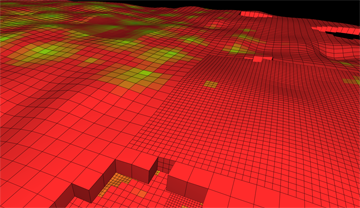
Multi-level TopS representation of an oil reservoir, provided by Tecgraf at PUC-Rio
Related Publications
R. Espinha, W. Celes, N. Rodriguez, and G. H. Paulino. “ParTopS: compact topological framework for parallel fragmentation simulations.” Engineering with Computers Vol. 25, No. 4, pp. 345-365, 2009.
R. Espinha, W. Celes, N. Rodriguez, and G. H. Paulino. “ParTopS: compact topological framework for parallel fragmentation simulations.” Engineering with Computers Vol. 25, No. 4, pp. 345-365, 2009.

